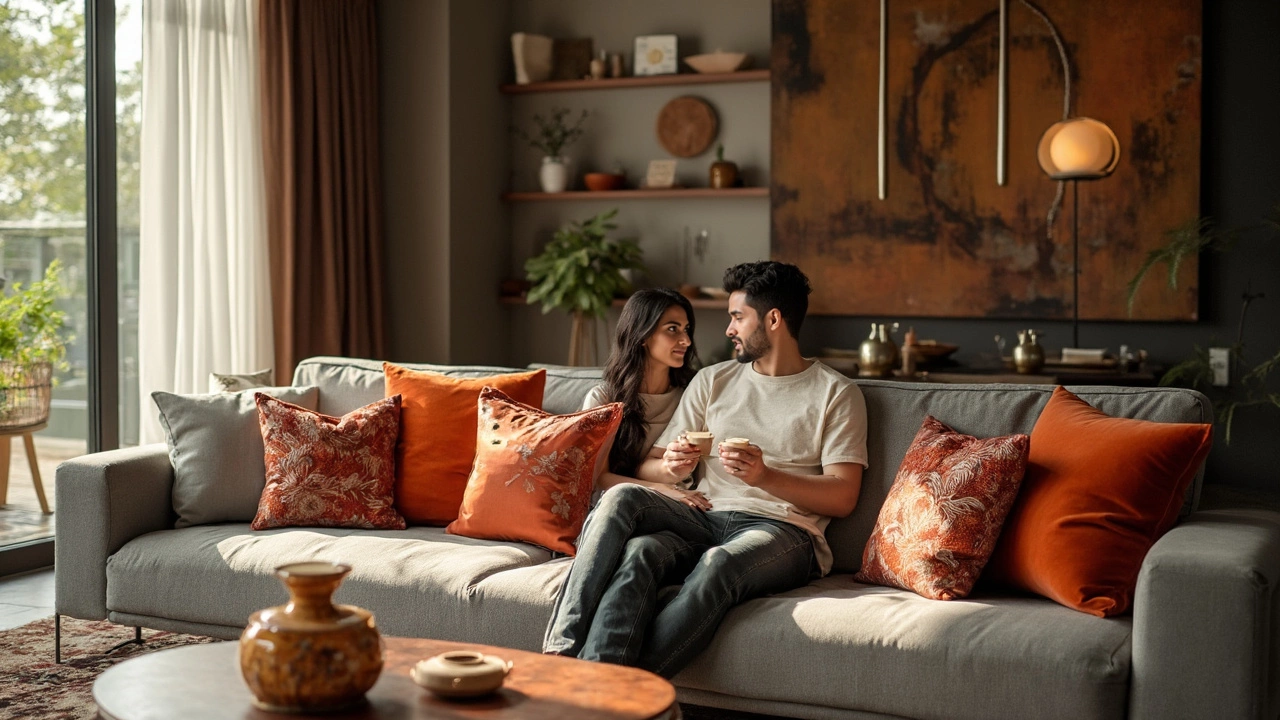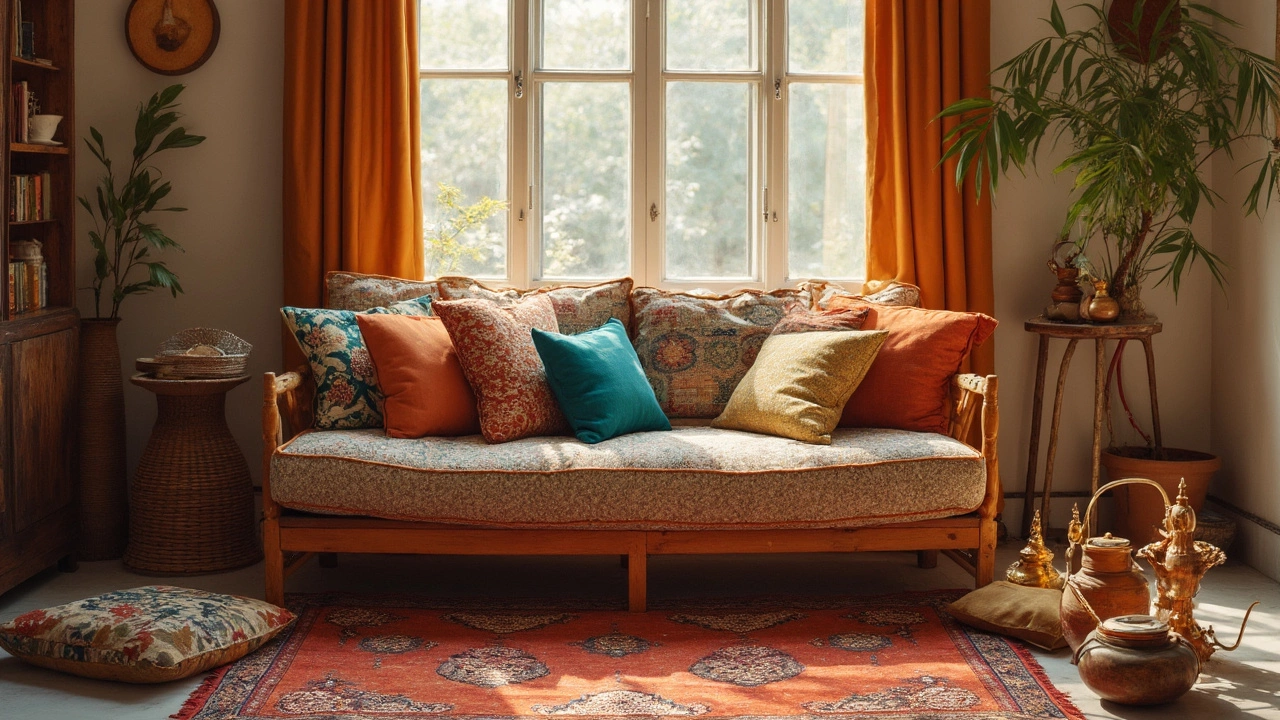The 60 30 20 rule isn't just decorator jargon; it's a straightforward strategy to make sure your room feels balanced yet dynamic, especially when it comes to cushions. It's all about proportion. You dedicate 60% of your cushion choices to a dominant color, 30% to a secondary color, and 10% to an accent. Why does this matter? Because it prevents color chaos and pulls everything together.
Think about your living room. Your main couch might be that soft grey—there's your 60%. Your secondary, maybe a navy or teal, makes its way through accent chairs or a rug—that's your 30%. Lastly, the accent, say a bright mustard or coral, shows up in a few key cushions. This rule keeps things visually appealing yet effortless.
But it's not all about colors. Patterns and textures matter too. You wouldn't want all your cushions slick and shiny; that's just uncomfortable. Mix things up with cozy knits, embroidered details, or maybe a smooth silk. Remember, it's about creating that ideal mix that reflects your style yet stays cohesive.
- What is the 60 30 20 Rule?
- Choosing the Right Cushions
- Balancing Colors and Patterns
- Tips for Practical Application
What is the 60 30 20 Rule?
The 60 30 20 rule is a go-to blueprint for many interior decorators aiming for balance and harmony in a space. It originated as a color theory principle, but it's such a versatile concept that it easily translates to various home decor elements, including cushions.
Here's the deal: imagine your room as a blank canvas. The '60' represents the dominant visual impression; usually, it's a background or base color that covers the largest area. This could be the color of your walls or your main furniture pieces. The '30' is your secondary splash, taking up about half the area compared to the main one. It adds depth and can show through other larger pieces like rugs, curtains, or larger art pieces.
The '20,' meanwhile, is all about that pop of interest - your accent. When it comes to cushions, the accent includes vibrant hues or exciting patterns that elevate the overall aesthetic without overwhelming it. Think of it as the fun detail that draws the eye and ties everything together.
This balanced approach means you avoid a space feeling too busy or too bland. With cushions, achieving the 60 30 20 proportion often involves experimenting with different textures and fabrics, not just colors. For instance, if your base hues are neutral, your accents could bring in texture with silk or velvet cushions, creating a visually inviting scene.
Choosing the Right Cushions
Picking the right cushions might sound easy, but there's more to it than just choosing what looks nice. Cushions are not just for comfort, they play a big role in your decorating game. Let’s dive into some factors to consider when choosing cushions.
Size and Shape Matter
First things first, consider the size and shape of your cushions. If you have a huge sofa, tiny cushions might get lost. Go for larger ones, and maybe even mix in a couple of interesting shapes—square, rectangular, or even round. This diversity adds visual interest without overwhelming the space.
Fabric and Texture
Next, think about fabric choice. Not only does it affect the feel and function, but fabric plays into the visual hierarchy of your room. Cushions can be explored through velvet's luxury, linen's casual vibe, or even the simple elegance of cotton. Remember, different materials can reflect light differently, adding an extra layer of texture.
Pattern Play
Don’t shy away from patterns. Stripes, florals, geometric shapes—the options are endless. But stick to a theme. Mixing geometrics with florals works when there’s a common color tying them together. This is where your knowledge of the 60 30 20 rule kicks in to maintain harmony.
Filler Choices
The inside counts too. Foam, feathers, polyester—all have different feels and impact the cushion’s look. Foam holds its shape well but might be firmer. Feathers add a plush, luxurious touch, but need plumping. Look for cushions with removable covers for easy maintenance too.
- Foam: Ideal for cushions needing structure.
- Feathers: Adds a softer, more luxurious feel.
- Polyester: Affordable and maintains the form nicely.
All these considerations can significantly enhance your interior design, making your home not just a living space but a personalized sanctuary.

Balancing Colors and Patterns
Getting the colors and patterns just right when using the 60 30 20 rule can make all the difference in your interior decor. It’s not a mystery; it's a balance act. First, consider the main color as your canvas. This should be a calm, neutral tone because it covers a big part of your room and lets the other colors shine.
Choosing Complementary Patterns
Now, onto the fun part—patterns! It’s easy to go overboard, but a few tips can keep you on track. Stick to three patterns at most: one bold, one medium, one subtle. This gives variety but keeps harmony. For example, if your dominant color is a soft grey, you might choose bold stripes for your secondary 30% and a delicate floral pattern for your accent 10%.
Texture in Focus
Color isn’t everything, texture counts a lot too. Mixing different cushion textures can add depth and interest. Imagine pairing a smooth satin cushion with a chunky knit and a velvet one. Each has a different feel, yet together they create a dynamic scene.
Practical Tips
- Always start with the 60% color and build around it—the furniture or big decor pieces often inform this.
- Use the 30% color to bring life and connect with other elements, like wall art or curtains.
- The 10% is your playful part, where a vibrant hue steals attention without overwhelming.
If you're still on the fence about what works, a color wheel can be your best friend. This handy tool shows which colors naturally go together. Often complementary or analogous color schemes are the safest bets for a comfy yet stylish space.
Tips for Practical Application
Applying the 60 30 20 rule with cushions might seem tricky at first, but it’s all about embracing a bit of creativity mixed with a plan. The idea is not just to have a room full of cushions, but to have each serving a purpose in your decor scheme.
Start with a Plan
Before you even think about buying cushions, look at what you already have at home. What are the main colors in your room? Use those as your starting point, and figure out your 60% and 30% colors. Your 20% accent should be something that pops but still blends nicely with the rest.
Choose the Right Sizes
Big cushions make a big statement, but smaller ones can be just as effective in layering. The key lies in varying sizes so there's depth. Think of stacking large, medium, and small cushions together. A general approach is to pick one or two large cushions, several medium ones, and a few small accent cushions.
Texture and Pattern
Don’t let your cushions fight each other for attention. If one has a bold pattern, let the others be more muted or in a solid color. Textures can warm up your space—a cable knit here, a velvet there, and suddenly, your room feels cozy.
Placement is Key
Balance is crucial. Avoid stuffing cushions on just one side of your couch. Spread them out evenly or in an aesthetically pleasing way across the furniture pieces. Even the angle or slightly tilted position can impact overall appearance.
Layer Like a Pro
Layering isn’t just for clothes. When arranging, put the largest ones at the back and smaller, more colorful ones in front. This method showcases all elements without overwhelming the space.
Quick Checks
- Step back and look. Does anything stick out too much or feel out of place?
- Does your accent color catch the eye without being jarring?
- Is the space functional, or do you have to remove cushions every time you sit?
These simple checks ensure your room remains practical, comfortable, and visually appealing.
Remember, your home should reflect your personality and be a place where you enjoy spending time. Using the 60 30 20 rule to arrange cushions is just one way to create a harmonious and inviting space.
